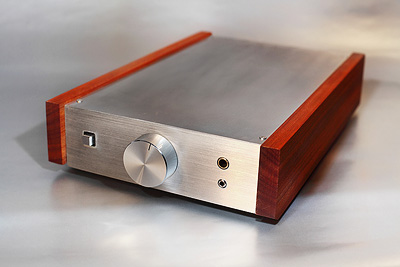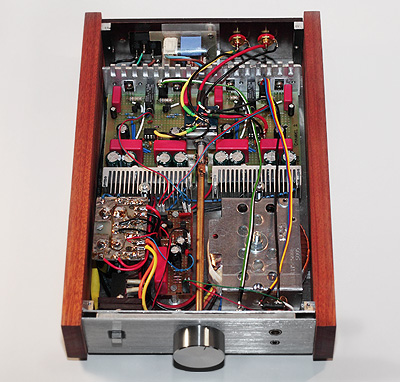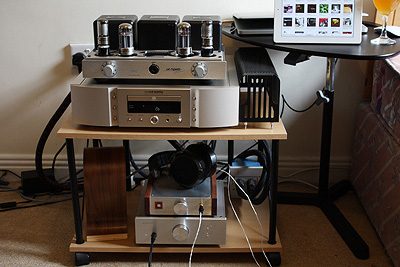In search for the perfect sound
Hi-End headphone amplifier
UPDATE! I will be bringing it to Head-Fi London Meet on 27th of April 2013.

As I already mentioned, as a kind of relax from my daily work I have finally decided to build a headphone amplifier
that was on my mind since some time now. I was about to create a very good amplifier, that would make my hours of
work nicer and allow to use a full potential of excellent headphones Sennheiser HD650 are.
As I am a keen audiophile, requirements I put on the design were very demanding. This headphone amplifier had to amplify
the signal from the PC card introducing minimum amount of harmonic distortions (THD) and noise.
The PC card I mentioned here is Prodigi HiFi 7.1, quite impressive Korean production with 4 independent outputs driven
by separate op amps sitting in DIL8 sockets, thus can be replaced by any compatible op amp of your liking.
The standard JRC4580 performed the best (!) then AD825, OPA2134 and OPA2604.
Unfortunately as in most PC sound card cases, the headphone output is directly connected to the op amp output.
This if obviously not enough to drive headphones even not so much demanding as e.g. Sennheisers HD600 or HD650.
I was able to make a design and build from scratch the amplifier you see below in just 8 weeks.
Its main tasks were to provide a small voltage gain (x4) and separate the output op amp of the PC card from the load.
Initially I wasn’t aware of one more parameter which is critical for such type of constructions.
I would even dare to say it is the most important.
More on this in the moment.
| Specifications: |
| Output power: | 2x8W |
| Output power (class A): | 2x2.3W |
| Number of inputs: | 1 (RCA) |
| Number of outputs: | 2 (mini-Jack, Jack) |
| Maximum output load (±10V i THD <0.1%): | 25Ω |
| Input load: | 10kΩ |
| Output impedance (30Ω-300Ω) 20Hz-20kHz: | 0.097-0.096Ω (5%) |
| Harmonic distortions THD: | 0.0004-0.0018% (*) |
| Harmonic distortions & noise THD+N: | 0.0015-0.0061% (**) |
| Intermodulation distortions IMD: | <0.0033% |
| Protection circuits: | Shortcircuit protection and delayed output on. |
| Power consumption: | 9W |
* - Internal measurement card THD is 0.0014%
** - Internal measurement card THD+N is 0.0046%
Construction

Power supply is based on a shared toroidal transformer and preliminary rectifier,
after which remaining parts of power supply chain and audio stage is completely separated.
Each channel power supply starts with second-order low pass filter followed by the voltage stabilisation based on
LM337 and LM317 chips. Their output voltage is smoothed out by a series of electrolytic and MKP (WIMA) caps.
Audio section begins with the BLUE Alps 10kΩ potentiometer. Then attenuated signal goes to the AD797 op amp,
which is regarded as one of the best for audio purposes available on the market. It has exceptionally low noise
and harmonic distortion levels and is used to drive complementary pair of bipolar transistors working in push-pull mode.
These are Hitachi SD669 and SB649, currently quite difficult to get, but their parameters such as similar gain
levels and wide frequency bandwidth (>100MHz) makes it perfect for output stages of headphone amplifiers.
I gave up adding input buffering stage from a simple reason, most of the audio sources do not afraid of simple
loads of around 10kΩ. This limited the number of active stages to a bare minimum and the same the amount of unnecessary
noises or distortions. AD797 has very good static specifications as well. That includes output voltage offset.
Total DC output voltage offset is less than 15mV for both channels. Therefore there is no need to employ a DC
servo circuit or separating capacitors which are never neutral for the sound quality and in particularly
for the frequency response level.
Output impedance
The amplifier is employed in number of protection circuits, which are to limit losses in case of
catastrophic failures like output transistor short circuit. But most of all they are about to protect usually expensive headphones.
In any such cases headphones are quickly disconnected from the amplifier.
Additional circuit eliminates initial unpleasant spikes by delaying the moment of enabling headphone output
by a couple of seconds. Thanks to it, the moment of turning the amplifier on is practically inaudible.
In the initial design I had 3.3Ω resistors connected in series to the headphones output to protect the amplifier
in case of short circuit. However the first listening sessions revealed some kind of lack of depth,
detail and air. I wasn’t expecting this from this kind of construction and made me a little bit disappointed.
Something was wrong and I wasn’t sure what.
Eventually my suspicion fell on pair of these resistors. After I removed them, I was completely shocked by
how far the sound quality improved. Music started breathing with air, sounds became full of details and stage
could be easily imagined. This proves that even for amplifiers of relatively small output power (like 2x2W)
the low output impedance is very critical. Using op amps with a large open feedback loop gain helped me
further improve it down to 50mΩ (for loads between 47-300 Ω).
This corresponds to 0.5mΩ for 200W power amplifiers and that is a quite decent result.
If we try to imagine, a strong amplifier with the low output impedance behaves as a hydraulic booster
that keeps a tight rein on the speaker’s diaphragm and does not allow it for any resonances or vibrations of its own.
But if the booster is connected with a soft, weak wire (which corresponds to the high output impedance) then
even the highest power won’t help you control speakers.
An easy way to demonstrate this phenomenon is to try to rotate a disconnected motor’s axis with fingers.
It should be fairly easy. Now try the same with the motor having electric connectors short circuited
(this corresponds to the amplifier’s very low output impedance). It won’t be easy anymore.
If magnets are strong enough rotating the axis with fingers becomes even impossible.
Listening session

During our latest listening session we managed to test and compare the amplifier in the following setup:
- Burson Conductor (DAC / Headphone Amp / Preamp) as DAC
- La Figaro 339 OTL Headphone Amplifier (heavily modded)
- Maranz SA-15S2 as CD transport
- My Headphone Amp
- Hifi Man HE500 headphones
- Sennheiser HD650 headphones
As a source of hi-res recording we used Mac connected to
Burson Conductor over USB.
Out first and consistent impression was that the amp is sounding very like a good tube amplifier.
There was strong similarity between my construction and La Figaro 339 and it was not easy to find
the differences at once. The bass is very well controlled, mid-range is vivid and full of air,
contours are not harsh and listening brings a lot of pleasure on both headphone amplifiers.
The Burson Conductor built it headphone amplifier was quite sharp in contrary. Details were prevailing
over the consistency of tracks and the mid-range wasn’t that juicy as in case of tube amp.
Therefore for the rest of the session we decided to focus on the comparison between La Figaro and
my prototype amplifier (I need to come up with some nice name for it eventually).
What is also worth stressing here is that my construction did not have any problems with
driving such a difficult load as HifiMAN HE500 headphones are. And these sound absolutely superior
over Sennheiser HD650... unfortunately (because I don’t own them).
As for direct comparison with the La Figaro OTL amplifier that was brought to the top of performance
by doing
an ultimate modding,
that was a very tough fight, as, believe me, this particular La Figaro sounds almost divine.
The tone of this tube amp is a bit brighter, contours of acoustic guitar as well as any other instruments
are a bit more perceptible and audible. In my opinion this is typical to all single-ended constructions,
which are not completely neutral to the sound as they usually add some amount of 2nd harmonic
by compressing the signal output levels. This makes details more palpable whereas strong signals like
basses are slightly weakened, which in turns makes midrange and high band less masked.
The ‘problem’ is that it makes the music sounding very pleasant and rich in full bodied details
and in case of this La Figaro there is no way you could say at any time it is sounding unnatural.

It is however close to the nature of tubes, by the fact the output transistors are working
in pure class A and because of wide amplification bandwidth. There is no effect of ringing
usually accused of the so called ‘bleeding ears effect’ (too strong feedback loop and limited
frequency bandwidth) therefore receipt of music is nice, pleasant and with absolutely no getting
the impression of harshness which unfortunately was a bit audible in case of Burson Conductor headphone output.
To conclude, my amplifier performs very well with either Sennheiser HD650 or with headphones with very low impedance,
e.g. HiFiMAN HE500 (38ohms). To reach the divine level however, there is still some short distance to overcome.
From the other hand I am comming to a conclusion, that it is a bit unfair to compare solid state
with tube amps. It is like trying to compare two glasses, the first having lens
made with single atom precision and the second glasses with lens boosting colors (like typical polarizing glasses).
Some will prefer faithfulness, others would prefer the sher pleasure of listening to the music.
Not always these two things come together.
The question that bothers me at the moment is how a perfect amplifier would sound like if used in this setup
(by perfect amplifier I mean the one with no distortions, noise and zero output impedance).
Radek Strugalski